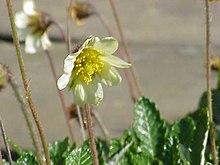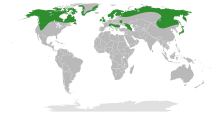| Dryas | |
|---|---|

| |
| Dryas × suendermannii | |
| Scientific classification | |
| Kingdom: | Plantae |
| Clade: | Tracheophytes |
| Clade: | Angiosperms |
| Clade: | Eudicots |
| Clade: | Rosids |
| Order: | Rosales |
| Family: | Rosaceae |
| Subfamily: | Dryadoideae |
| Genus: | Dryas L. |
| Species | |
|
See text | |

| |
| Synonyms | |
| |
Dryas is a genus of perennial cushion-forming evergreen dwarf shrubs in the family Rosaceae, native to the arctic and alpine regions of Europe, Asia and North America. The genus is named after the dryads, the tree nymphs of ancient Greek mythology. The classification of Dryas within the Rosaceae has been unclear. The genus was formerly placed in the subfamily Rosoideae, but is now placed in subfamily Dryadoideae.
The species are superficially similar to Geum (with which they share the common name avens), Potentilla, and Fragaria (strawberry). However, Dryas are distinct in having flowers with eight petals (rarely seven or up to ten), instead of the five petals found in most other genera in the Rosaceae. The flowers are erect and white with a yellow centre (Dryas integrifolia, Dryas octopetala) or pendulous and all-yellow (Dryas drummondii), and held conspicuously above the small plants. This makes them very popular in rockeries and alpine gardens. The hybrid Dryas × suendermannii, with cream coloured flowers, has gained the Royal Horticultural Society's Award of Garden Merit.
Dryas tolerates a wide variety of unshaded habitats, including alpine situations with sand or gravel substrate, similar substrates in flat tundra lowlands, and also fen habitats upon organic substrate where some shading from adjacent sedges or shrubs may occur.
The Younger Dryas and Older Dryas stadials are geological periods of cold temperature that are named after Dryas octopetala, which flourished during that time and is used as a fossil indicator of those periods.
Gallery
-
 Dryas drummondii – Drummond's avens
Dryas drummondii – Drummond's avens
-
 Dryas integrifolia – entire-leaved avens
Dryas integrifolia – entire-leaved avens
-
 Dryas octopetala – mountain avens
Dryas octopetala – mountain avens
Taxonomy
Species
Dryas comprises three species, but the genus is in need of taxonomic revision:
- Dryas drummondii Richardson ex Hook. – Drummond's avens
- var. drummondii Richardson ex Hook. – Yellow avens
- var. tomentosa (Farr) L.O. Williams – Tomentose avens
- Dryas integrifolia Vahl – Entire-leaved avens
- subsp. chamissonis (Spreng.) Scoggan – White avens
- subsp. crenulata (Juz.) J. Kozhevn – Crenulate avens
- subsp. integrifolia Vahl – Entire-leaved avens
- subsp. sylvatica (Hultén) Hultén – Forest avens
- Dryas octopetala L. – Mountain avens
- subsp. alaskensis (A.E. Porsild) Hultén – Alaskan avens
- subsp. hookeriana (Juz.) Hultén – Hooker's avens
- subsp. octopetala L. – Eight-petal avens
- var. angustifolia C.L. Hitchc. – Narrow-leaved avens
- var. argentea Blytt – Silvery avens
- var. kamtschatica (Juz.) Hultén – Kamtschatca avens
- var. octopetala L. – Eight-petal avens
- subsp. punctata (Juz.) Hultén – Pointed avens
Species names with uncertain taxonomic status
The status of the following species is unresolved:
- Dryas camschatica Juz.
- Dryas dasypetala Juz.
- Dryas grandis Juz.
- Dryas henricae Juz.
- Dryas incisa Juz.
- Dryas integrifolia C.A.Mey. ex Juz.
- Dryas integrifolia Ledeb.
- Dryas kamtschatica Juz.
- Dryas longifolia C.A.Mey. ex Juz.
- Dryas octopetala J.G.Gmel.
- Dryas octopetala M.Bieb.
- Dryas octopetala Makino
- Dryas oxyodonta Juz.
- Dryas sumneviczii Serg.
- Dryas viscosa Juz.
Hybrids
Two hybrids have been described:
- Dryas × suendermannii Kellerer ex Sundermann—(D. drummondii × D. octopetala)
- Dryas × wyssiana Beauverd—(D. drummondii × D. integrifolia)
Species names with uncertain taxonomic status
The status of the following hybrids is unresolved:
- Dryas × chamissonis Jurtzev
- Dryas × grandiformis Jurtzev
- Dryas × intermedia Juz.
- Dryas × lewinii Rouleau
Nitrogen Fixation
Some Dryas plants have root nodules that host the nitrogen-fixing bacterium Frankia.
- Dryas drummondii forms root nodules and fixes nitrogen with Frankia.
- Dryas integrifolia does not form root nodules or fix nitrogen with Frankia.
- Dryas octopetala does not form root nodules or fix nitrogen with Frankia.
- Dryas × suendermannii (D. drummondii × D. octopetala) does not form root nodules or fix nitrogen with Frankia.
References
- ^ Govaerts R. "Dryas L." Plants of the World Online. Board of Trustees of the Royal Botanic Gardens, Kew. Retrieved 14 December 2020.
- Morgan DR, Soltis DE, Robertson KR (1994). "Systematic and evolutionary implications of rbcL sequence variation in Rosaceae". Am J Bot. 81 (7): 890–903. doi:10.2307/2445770. JSTOR 2445770..
- Eriksson, Torsten; et al. (2003), "The Phylogeny of Rosoideae (Rosaceae) Based on Sequences of the Internal Transcribed Spacers (ITS) of Nuclear Ribosomal DNA and the trnL/F Region of Chloroplast DNA" (PDF), International Journal of Plant Sciences, 164 (2): 197, doi:10.1086/346163, S2CID 22378156
- Potter D, Eriksson T, Evans RC, Oh S, Smedmark JEE, Morgan DR, Kerr M, Robertson KR, Arsenault M, Dickinson TA, Campbell CS (2007). "Phylogeny and classification of Rosaceae". Plant Systematics and Evolution. 266 (1–2): 5–43. doi:10.1007/s00606-007-0539-9. S2CID 16578516..
- "RHS Plantfinder - Dryas × suendermannii".
- "AGM Plants - Ornamental" (PDF). Royal Horticultural Society. July 2017. p. 33. Retrieved 24 January 2018.
- Connor, Simon E.; Kvavadze, Eliso V. (2009). "Modelling late Quaternary changes in plant distribution, vegetation and climate using pollen data from Georgia, Caucasus". Journal of Biogeography. 36 (3): 529–545. doi:10.1111/j.1365-2699.2008.02019.x. hdl:11343/55209. S2CID 83949372.
- Skrede I, Eidesen PB, Piñeiro Portela R, Brochmann C (2006). "Refugia, differentiation and postglacial migration in arctic-alpine Eurasia, exemplified by the mountain avens (Dryas octopetala L.)". Molecular Ecology. 15 (7): 1827–1840. doi:10.1111/j.1365-294X.2006.02908.x. PMID 16689901. S2CID 44667191.
- ^ "The Plant List entry for Dryas". The Plant List, v.1.1. Royal Botanic Gardens, Kew and the Missouri Botanical Garden. September 2013. Retrieved 14 December 2020.
- Swensen SM, Mullin BC (1997). "The impact of molecular systematics on hypotheses for the evolution of root nodule symbioses and implications for expanding symbioses to new host plant genera". Plant and Soil. 194 (1/2): 185–192. doi:10.1023/A:1004240004063. JSTOR 42948119. S2CID 35125701..
- Becking JH (1984). "Identification of the endophypte of Dryas and Rubus (Rosaceae)". Frankia Symbioses. Vol. 78. pp. 105–128. doi:10.1007/978-94-009-6158-6_11. ISBN 978-94-009-6160-9. JSTOR 42934565.
{{cite book}}:|journal=ignored (help) - Kohls SJ, Baker DD, van Kessel C, Dawson JO (2004). "An assessment of soil enrichment by actinorhizal N2 fixation using δN values in a chronosequence of deglaciation at Glacier Bay, Alaska". Plant and Soil. 254 (1): 11–17. doi:10.1023/A:1024950913234. S2CID 25039091.
- ^ Kohls SJ, van Kessel C, Baker DD, Grigal DF, Lawrence DB (1994). "Assessment of N2 fixation and N cycling by Dryas along a chronosequence within the forelands of the Athabasca Glacier, Canada". Soil Biology and Biochemistry. 26 (5): 623–632. doi:10.1016/0038-0717(94)90251-8.
- Deslippe JR, Egger KN (2006). "Molecular diversity of nifH genes from bacteria associated with high arctic dwarf shrubs". Microbial Ecology. 51 (4): 516–25. doi:10.1007/s00248-006-9070-8. PMID 16649061. S2CID 11453460.
- Markham JH (2009). "Does Dryas integrifolia fix nitrogen?". Botany. 87 (11): 1106–1109. doi:10.1139/B09-071.
- (Reported as Dryas drummondii var. eglandulosa.) Kohls SJ, Thimmapuram J, Buschena CA, Paschke MW, Dawson JO (1994). "Nodulation patterns of actinorhizal plants in the family Rosaceae". Plant and Soil. 162 (2): 229–239. doi:10.1007/BF01347710. JSTOR 42939545. S2CID 36071796.
External links
| Taxon identifiers | |
|---|---|
| Dryas |
|